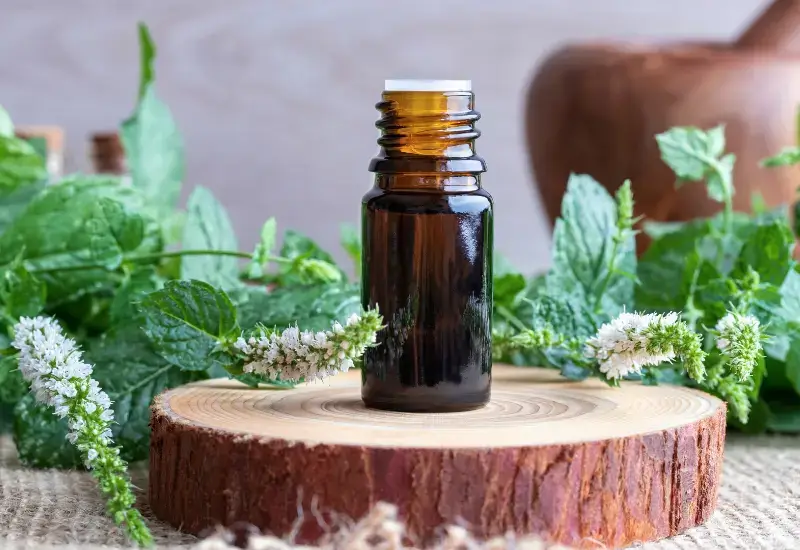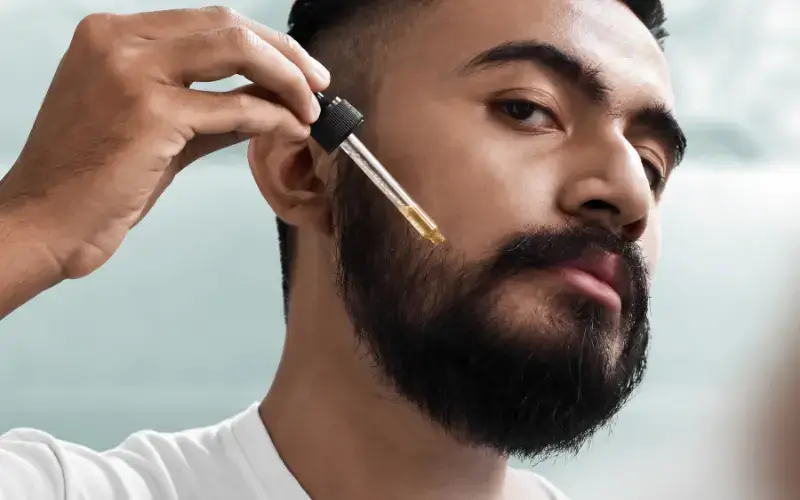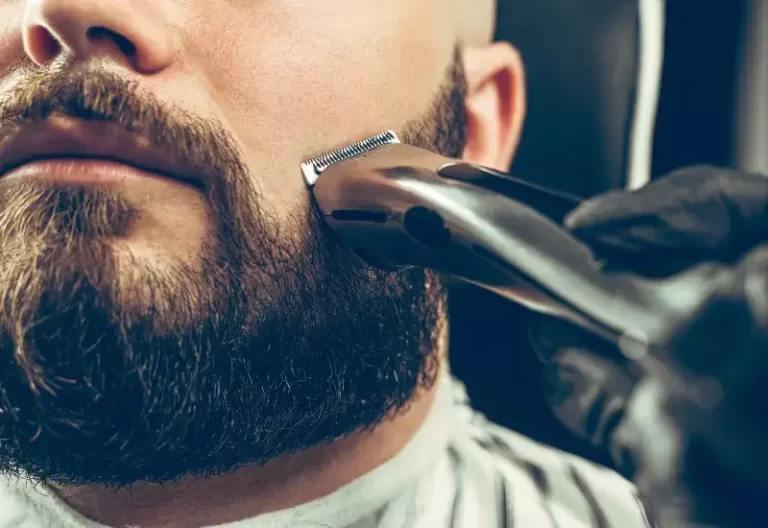You’d love the cheeks hair growth if you are like me and don’t want to blend a beard into a fade. In this guide to beard growth on cheeks, you’ll learn how to naturally grow a beard on the cheeks and with beard products.
From now on, you’ll not wonder, “Why doesn’t my beard grow on my cheeks? But you must understand that beard growth takes time! You need a proper beard care routine to stop an itchy beard and keep beard hairs from sticking out.
How to Grow a Beard on Cheeks Naturally?
By the end of this post, I’ll answer some of the most frequently asked questions about growing a beard on your cheeks. Sounds great? Let’s get into it.
1/ Eat Healthy Foods to Get Beard On Your Cheeks
Eating the right foods is crucial for beard growth, especially for cheeks. Foods rich in protein, healthy fats, high-fiber fruits, and green vegetables can stimulate hair growth and improve skin health, promoting a fuller beard.
Let me share the most essential nutrients to nourish your beard and the sources.
| Nutrient | Benefits | Food Sources |
|---|---|---|
| Protein | Protein is the building block of hair. | Meat, fish, eggs, dairy, beans, lentils, nuts, and seeds. |
| Biotin | Helps to convert food into energy. | Eggs, liver, salmon, avocado, sweet potato, and nuts. |
| Zinc | Helps to regulate testosterone levels. | Oysters, red meat, poultry, beans, nuts, and seeds. |
| Iron | Helps to carry oxygen to the hair follicles | Red meat, poultry, beans, lentils, leafy green vegetables, and fortified cereals. |
| Vitamin A | Helps to protect the hair follicles from damage | Carrots, sweet potatoes, spinach, kale, cantaloupe, and mango. |
| Vitamin C | Helps to produce collagen | Citrus fruits, strawberries, broccoli, Brussels sprouts, and bell peppers. |
| Vitamin E | Helps to protect the hair follicles from damage | Almonds, spinach, avocados, hazelnuts, sweet potatoes, and mangoes. |
| Omega-3 fatty acids | Help to reduce inflammation, preventing beard hair loss. | Fatty fish, such as salmon, tuna, mackerel, walnuts, flaxseeds, and chia seeds. |
| Selenium | Helps to protect the hair follicles from damage | Brazil nuts, tuna, shellfish, sunflower seeds, wheat germ, and whole wheat bread. |
| Copper | Helps to produce melanin, which is the pigment that gives hair its color | Oysters, beans, lentils, nuts, seeds, whole grains, dark leafy greens, and cocoa. |
| Folate | Helps to regulate cell growth | Leafy green vegetables, beans, lentils, citrus fruits, whole grains, and fortified cereals. |
| Niacin | Helps to convert food into energy. | Meat, poultry, fish, whole grains, and enriched cereals. |
All these nutrients will naturally grow a beard on your cheeks.
2/ Let Your Beard Naturally Grow on the Cheeks
You must learn how long it takes to grow a beard. It usually takes 6 months after you start growing it. During these months,
- Regularly trim and shape your beard to keep it neat.
- But avoid shaving the cheek area to ensure your facial hair grows fully.
- And don’t forget to wash your beard with a mild shampoo.
The takeaway here is to nourish and wait to see the results!

3/ Change Your Beard Styles Accordingly
When you experiment with different beard styles, the growth pattern of your beard is influenced and may encourage fuller growth on the cheeks.
Let’s delve into some powerful beard styles for this:
- The Full Beard: This classic style promotes uniform growth, including the cheeks. By letting all your facial hair grow at the same pace, you create an environment that encourages hair on your cheeks to sprout.
- The Corporate Beard: This style involves growing your beard evenly across the face, including the cheeks. It’s a well-groomed style that requires regular trimming but leaves enough hair on the cheeks to create natural growth.
- The Beardstache: This style combines a heavier mustache with a lighter beard. It requires allowing the hair on the cheek area to grow, which can help stimulate hair growth in those areas.
The easiest way to experiment with beard styles is to buy a trimmer that fits your needs. And use a quality beard comb and brush to distribute natural oils properly.
And if you cannot naturally grow a beard on your cheeks, why not try other beard styles that suit you? Even the celebs chose to change their beard styles just because they had a patchy beard. Why not you?
4/ Follow the Proper Beard Care Routine
Adopting a proper beard care routine is essential to nourish your facial skin and hair. It will ensure the growth of a healthy, shiny beard on your cheeks.

Here’s what your beard care routine should look like:
- Cleanse your face with lukewarm water every day.
- Use a quality beard wash and shampoo to clean the beard and pores.
- Apply a natural oil or balm to moisturize your skin and hair.
- Comb the beard in a downward direction to soften it up.
- Use a boar bristle brush every day to stimulate blood circulation.
- Trim your beard regularly to maintain its shape, but avoid the cheek area.
Also, ensure to buy high-quality beard products that don’t contain any harsh chemicals or additives. Let me share my top recommendation in the table.
5/ Assess Your Hormonal Balance

There’s a direct relation between your hormones and beard growth. That’s why you must assess your hormonal balance to encourage facial hair on the cheeks.
And testosterone is one of the key hormones that play a significant role in beard growth, especially on your cheeks. So, if you don’t have enough testosterone, it could be the reason behind slow or patchy beard growth on your face.
You can go for hormone therapy to balance your testosterone levels. And also, look for natural ways like exercise and having a healthy diet, as mentioned in the above point, to stimulate facial hair growth on cheeks.
6/ Take Supplements & Serums That Boost Hair Growth
A balanced diet should be your first port of call when trying to naturally grow a beard on your cheeks. However, if consuming enough protein and saturated fats is challenging, consider dietary supplements.
Supplements or serums can help you get enough nutrients to grow a cheeks beard faster. Let me share my recommended supplements containing protein and saturated fats:
- Supplement 1
These are some of the best supplements to help grow your beard. Consult a healthcare professional before starting any new supplement to ensure safety and suitability.
7/ Use a 3% Dilution of Peppermint Oil
Peppermint oil is one of the best ways to naturally grow a beard on the cheeks. It helps to stimulate hair follicles and encourages beard growth.

But, you must dilute the peppermint oil with a carrier oil like jojoba or coconut before applying it to your skin.
Here’s how to use it:
- Take a 3% mix of peppermint oil in any carrier oil.
- Massage it into your skin and beard with your fingertips.
- Leave the oil on for at least 15 minutes before washing it off.
- Use this remedy 2-4 times weekly to stimulate your hair follicles and encourage beard growth.
8/ Try Derma Roller or Micro-needling devices
Using a derma roller and micro-needling for beard growth involves using tiny needles to create micro-injuries in the skin.
The derma roller has shorter needles and can be used at home for mild beard growth issues. On the other hand, micro-needling is a professional treatment with deeper needle penetration, which may be more effective for you.
A derma roller is a small, handheld device that has tiny needles. It helps to improve blood circulation and stimulate hair follicles on your cheeks. Buy this Beard Derma Roller by Thapink for the best results.
Here’s how to use it:
- Cleanse your face and beard with lukewarm water.
- Apply oil or serum to help the roller glide effortlessly over your skin.
- Roll the derma roller up-down, left-right, and diagonally direction continuously.
Use the derma roller 2-4 times a week for at least 10 minutes per session to encourage natural beard growth on your cheeks.
Consult a skincare professional to determine the best option for promoting beard growth based on your needs.
9/ Use Rogaine (5% Minoxidil) for Beard Cheeks
Minoxidil helps to stimulate hair growth and encourages it to grow thicker. It works by increasing the blood circulation in the scalp, so you can use it to grow a beard on your cheeks naturally. However, there’s no scientific evidence to prove it.
If you want to try this solution to grow a beard on the cheeks, go for Rogaine with 5% of Minoxidil for the optimal beard growth. Rogaine is a brand name for a product that contains Minoxidil.

Again, consult a skincare doctor to determine if it’s safe and suitable.
10/ Get a Beard Transplant As the Last Resort
A beard transplant involves the removal of hair follicles from one area and implanting them in another. It’s a surgical procedure that can help you grow a beard on your cheeks.
This is the only way that you can almost guarantee results. But it’s not natural, of course! And it’s expensive as well. The recovery time is around 4-6 months after the surgery.
The first step? Go to an excellent cosmetic surgeon that can beards.
FAQs on Growing Beard on Cheeks
Question-answer time now!
Why doesn’t a beard grow on the cheeks?
A beard doesn’t grow on the cheeks primarily because of your genetics. But, some factors can prevent beard growth on the cheeks, including Alopecia Areata, clinically low testosterone, age, and nutrient deficiencies.

Let me get into a bit of detail.
Alopecia Areata: An autoimmune disorder called alopecia areata can lead to patchy hair loss on the head or beard. This condition causes the body to attack hair follicles, resulting in sparse hair growth on the cheeks.
Low Testosterone: Low levels of testosterone can inhibit beard growth. Someone with clinically low testosterone levels may experience difficulty growing a beard and other symptoms like irritability, low sex drive, and erectile dysfunction.
Your Age: For most men, beard growth continues to improve into their 30s. Younger individuals in their 20s may notice that their beard fills out and becomes fuller as they age.
Nutrient Deficiencies: A deficiency in essential minerals or vitamins can limit beard growth. Extremely low levels of protein, for example, can interfere with the body’s production of testosterone, which affects beard growth.
Genetic Factors (Race): Race is also a genetic factor that may influence beard growth. Studies have shown that Chinese men tend to have sparser hair growth on their cheeks and necks than Caucasian men.
Can I encourage beard growth on the cheeks?
Yes, you can encourage beard growth on your cheeks naturally. Here’re some proven methods to do so:
- Eat a balanced diet rich in proteins and saturated fats.
- Exercise regularly to increase testosterone production.
- Change your beard style to suit your needs.
- Follow a proper beard care routine to nourish your beard.
- Choose hormone therapy to balance your testosterone levels
- Go for all-natural beard balms like this one. Read Honest Amish Balm’s review.
- Use Rogaine with 5% Minoxidil dilution.
- Take supplements, serums, derma rollers, or microneedling devices.
- Natural oils like jojoba, coconut, or peppermint moisturize the skin and stimulate hair follicles.
How long does it take for a cheek beard to grow?
The time for fully-grown beard hair on the cheeks depends on several factors, such as genetics, nutrition, and lifestyle. Generally, a cheek beard takes around 4-6 weeks to grow after you have a fuller beard.
And it takes 4-6 months for a full beard after you have started growing it. Some beards may take longer to grow, and some may take less time.
You can speed up the process by following proper hair care routine and taking good care of your overall health. Eat a balanced diet, exercise regularly, get enough sleep, and reduce stress levels to stimulate.

How to grow a beard on your cheeks at home?
You can grow a beard on your cheeks at home with some simple steps.
Here’s what you need to do:
- Cleanse your face and apply a light facial moisturizer to keep it hydrated.
- Follow proper beard care routine.
- Massage your face with a beard brush or comb to stimulate the hair follicles.
- Wash your beard twice a week with gentle shampoo and conditioner.
- Apply natural oil to help keep it healthy.
- Eat a balanced diet rich in proteins and essential vitamins and minerals.
- Exercise regularly to boost testosterone production.
- Reduce stress levels as it can inhibit beard growth.
- Try natural supplements or serums to help grow your cheeks and beard.

What are some beard growth myths I should be aware of?
There are a lot of beard growth myths out there. I share some common ones you should know before worrying about your facial hair growth.
Shaving more often can increase hair growth rate:
This is false, as shaving does not affect the speed at which your beard grows. You may see different results because of how and where you shave, but shaving does not influence the speed of beard growth.
Eating eggs can help you grow a thicker beard:
This is also false, as there’s no evidence to suggest that consuming eggs or any other food impacts facial hair growth.
If you pluck out hairs from your facial area, more will grow in its place:
False again! Plucking out the hair will not encourage more hair to grow in its place.
Taking supplements can help grow a thicker beard:
There’s no scientific evidence that taking vitamins and minerals can increase facial hair growth. But, some supplements may be beneficial if you have any nutritional deficiencies.
Increased testosterone levels contribute to the growth of a fuller and denser beard.
While testosterone does play a role in beard growth, it doesn’t necessarily make your beard thicker, according to this study.
So that’s all – I hope you have learned how to grow a beard on cheeks naturally.




